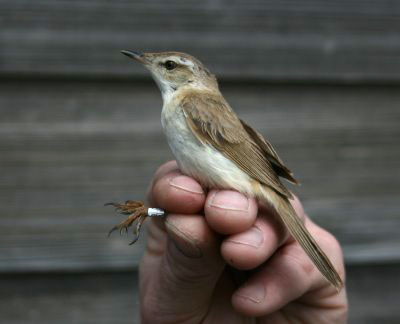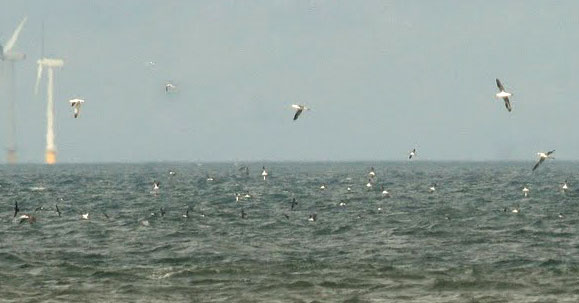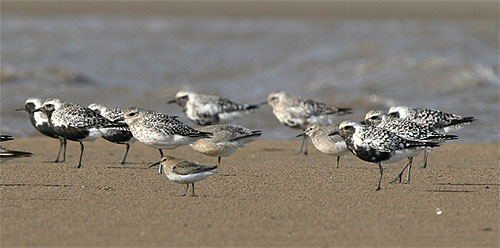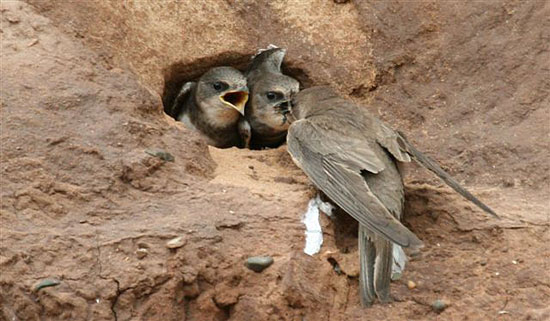Site menu:

September 2009 Newsletter
Paddyfield Warbler - Hilbre.
August Bird News.
Forthcoming Events.
Latest Newsletter.
The regular crew of Hilbre Bird Obs members had been working hard on the islands this spring to maintain the coverage as high as possible in true 'bird observatory tradition'. This had brought some very nice rewards, but no star bird, unlike the previous few springs.
As is typical at Hilbre things had gone very quiet at the end of May, but a Reed Warbler on 25th May was a good record (only the ninth for the island) and early June is notorious elsewhere in the country for mega birds. So once again a conscious effort was made to extend 'the spring' into June. Indeed Steve Williams wrote on the Obs blog site on 3rd June that 'The coverage by observers remains good despite the lack of birds - perhaps "the big one" is just around the corner...'
John Elliott had gone to Hilbre on 5th June 2009 to undertake a routine survey of the breeding birds as he has been doing for almost ten years now. It was a bright, sunny day and he arrived on the main island at 7:30am and started the survey right away. He also opened the catching boxes of Hilbre's three Heligoland Traps and set up a mist net in the Old Obs garden in the process. The breeding bird survey was completed as were several circuits of the Heligoland Traps without seeing or catching many birds at all.
Steve, who had hoped to get to the island that morning but who had a meeting to attend, rang John to find out if there was much about. 'No it's very quiet' John replied. However, that all changed by late morning. John was on another circuit of the traps when, as he stepped into the 'Newton' trap, about halfway down the trap, a small, pale bird flew out of rough cover on the floor of the trap and went relatively easily into the catching box.
His first impression of the bird was that it looked like a small, pale Reed Warbler. When John extracted it from the catching box he realised that he had never seen or handled a bird of this species before.
In true TV quiz programme tradition John decided to 'phone a friend' ... but, disaster struck, he had hardly any credit on his phone! Fortuitously for Steve, his meeting had been cancelled and he was at home in West Kirby when he received a text from John 'Please call me now'. There then followed a few anxious moments when he could not get through and Steve was concerned for John's safety not knowing the reason for the rather blunt but somewhat cryptic message... eventually the two spoke and immediately discussed the bird that John had caught and Steve's concern for John turned to excitement.

From John's brief description, Steve realised immediately that it was something exceptional and we went about starting to identity it. It was almost certainly an acrocephalus but we did not immediately rule out a small hippolais - particularly Booted, which seemed a likely candidate in early June. However, adding to the general description of the bird in the hand, was its wing length of just 56mm and the bird's notched primaries, it was fast becoming apparent that it was most likely a Paddyfield Warbler!
The telephone discussion ended with John now convinced that the bird was a Paddyfield Warbler and Steve well on the way to being convinced; although he could not say for certain until he saw the bird for himself.
Steve and his brother Chris (Chairman of the Obs) then
rushed to the island, through the ebbing tide. Steve's first reaction on
seeing the bird was to confirm the identification as Cheshire and Wirral's
first Paddyfield Warbler - he immediately handed the bird to Chris and
began to telephone the news out, ringing Obs members and bird information
services.
Chris checked all the measurements John had taken and confirmed that they
were correct and the bird was ringed, weighed and photographed. A detailed
description and full biometrics were taken, as is required by the BTO for a
rarity submission to the BBRC of a bird caught.
Meanwhile, a number of local Obs members had arrived and were delighted to
see the bird just prior to its release. Unfortunately, others arrived too
late, after the bird had been released back into the area it was caught and
despite searching later in the day it was not seen again that day.
Biometrics
The bird's biometrics were as follows:
Wing Length - 56mm; Bill Length - 13.8mm to skull, 8.3mm to feathers.
Primaries 3, 4 and 5 were emarginated although the emargination on 5 was
less than the other 2 feathers. Primaries 2 and 3 had notches, the notch on
2 was 13mm long and that on 3 was 10mm. The distance between the start of
the notch on 3 and the tip of the secondaries was 3mm.
The first primary extended 2mm beyond the primary coverts. The second
primary length was such that its tip fell between primaries 5 and 6. The
bird weighed 9.4grams and had a fat rating of 2 using the European Science
Foundation (ESF) system.
Brief Description
Head
The bird had a very clear cream/white supercilium that extended from the
top of the bill to well behind the eye. There was a dark eye stripe that
started in front of the eye and continued behind it. However, the bird
lacked the dark line above the supercilium that Paddyfield Warblers often
show in Autumn (see photograph below by Steve Stansfield of
Bardsey bird in October 2008). The eye itself was a pale, dull olive
colour.
The upper mandible was all dark, almost black and so was the distal end of
the lower mandible. The proximal end of the lower mandible was a pale straw
colour. The nasal
hairs were very prominent, quite long and very black.
Upper Parts
The upper parts of the bird were pale, sandy brown but the rump and upper
tale coverts were darker and had a rufous tinge. The wings were rounded and
relatively short and the primary projection was short, a quarter of the
length of the tertials. The tail was relatively long and rounded.
Under Parts
The under parts of the bird's body were a pale, creamy white. The under
tail coverts were the same pale colour, not streaked and were long,
reaching half way down the central tail feathers. The bird's legs were
straw coloured with a hint of pink.
Voice
The bird was quite vocal in the hand even being heard over the telephone
making some loud 'kerrring' and 'clicking' noises.
Age
The bird's primaries were bleached and abraded. The state of the primaries
suggested a bird that was in its first year.
Svensson states that first year birds have a slightly different wing
formula in relation to the length of the second primary. This bird fell
neatly within that assessment in that its second primary fell between the
fifth and sixth primaries; in older birds the second primary would be in
the length range 6/8.
The emargination on the fifth primary was quite
difficult to see and Svensson suggests that first year birds do not always
have emargination on the fifth primary. The eye was a dull olive colour
rather than a bright colour which is again consistent with first year
birds.
These four factors suggested that the bird was hatched during 2008.
Further sightings
A small gathering of Obs members arrived on the island on Saturday 6th
June, but it was an awful day weather-wise with torrential rain and the day
was reserved for basking in the glory and excitement of the previous day
and copious amounts of tea-drinking. There was no sign of the bird that day
and it was assumed to have gone. There was no coverage on the island by Obs
members on Sunday, but on the Monday Obs regular Derek Bates was on the
island when he flushed a small, pale warbler which he thought was ringed
from the brambles near the lower paddock.
He assumed it was the Paddyfield, which he had seen on the Friday, as there
had been no other warbler ringed on the island since the Reed Warbler at
the end of May! Meanwhile, another Obs member (Barry Barnacal) arrived and
also flushed the bird, this time from bracken in the lower paddock. Once
again it went to ground.
On the Tuesday (9th) ringing activities recommenced, meanwhile, the bird
was seen briefly in the field by a visiting birder who had spent many
patient hours (including the previous Friday afternoon) watching the
trapping area from the 'air-raid shelter'. The bird was retrapped later
that day and found to have gained 0.6 grammes.
The bird was quickly released into the same area it was caught and despite
flying off south towards the Obs garden, it was back again in the lower
paddock that evening when it was seen in the cliff-top blackthorn hedge at
8pm; the last sighting of the bird.
Not only an incredible bird for Hilbre (certainly the rarest ever to be
caught there), but also a first record for Cheshire and Wirral and only the
third record ever in the North West.
The previous two North West records being a single on Walney between 11th
and 13th September 1982 and one on Bardsey on 11th October 2008 (see BNW
Vol 5:10 pp249¬251).
It just goes to show that the big one really could be just around the
corner. . .
John Elliott and Steve Williams - June 2009
This article was first published in Birding North West Volume 6 No 6, and reproduced here with kind permission of the Editors.
August Bird News
Although skuas were scarce, and we didn't get a single Storm Petrel, it wasn't a bad month for sea birds. For me the highlight were Manx Shearwaters - there was a feeding flock several hundred strong which appeared to stay in the mouth of the estuary for about 10 days. Two days stand out - the 19th when at least 700 were counted from Hilbre, with many very close to the north end, and the 26th when there were 460 just off Red Rocks were I was standing with my telescope. There were plenty of Gannets in the same area with a max count of at least 350 counted from Red Rocks on the 17th. There were 12 records of one to two Arctic Skuas, not bad, but for the previous two Augusts sightings were just about daily with many counts in double figures. To make up for this we had a lovely adult Pomarine Skua with spoons come into the River Mersey off New Brighton on the 28th during strong west winds. On the same day the only petrel seen this month was off Hilbre - a Leach's.

As usual Sandwich Terns were much in evidence early in the month with a max count of 1,050 on West Kirby shore on 8th. They seem to have had a good breeding season with 15 to 20% juvs in the flocks. Numbers of Common Terns were low for most of the month, no doubt because of the desertion of the Shotton colony early in the summer. There was just one high count - 400 on West Kirby shore on the 8th. 156 Little Terns were at West Kirby on the 10th, with a much rarer juv Roseate tern at West Kirby the previous day. There were three Black Terns at New Brighton on the 29th and singles on another three dates.

Aug 25th, © Steve Seal.
Good numbers of waders were observed passing through and/or returning. Max were 10,400 Dunlin (Hoylake), 800 Ringed Plover (West Kirby), 400 Grey Plover (Meols), 6,200 Redshank (Heswall), 2,150 Curlew (Heswall) and 6,000 Oystercatcher (West Kirby). Rarer waders included 25 Greenshank at Parkgate, 8 Common Sandpiper at Connah's Quay, 2 Wood Sandpiper at Inner Marsh Farm and 6 Green Sandpiper both at Inner Marsh Farm and Shotton.
It was a good month for Marsh Harriers with ten reports of single birds and three of two, no doubt many were of the same birds. There were also eight reports of a single Hen Harrier, a ringtail.

This family of Sand Martins were nesting in the cliffs at Thurstaston, the first time they have nested here for over 30 years (photo by Charles Farnell)! They are a very rare breeding bird on Wirral.
Richard Smith.
What to expect in September
September is the month every birder looks forward to, particularly in our area. Our Liverpool Bay coast, in particular north Wirral coast, Hilbre and Point of Ayr, is nationally renowned as the best place in the country to see Leach's Petrels and September is the best month to see them. They aren't guaranteed though - unless we get strong to gale force north-west winds. The longer and stronger the winds blow, the more we will see. The best place to observe them can vary dependent on the exact weather conditions and state of the tide, but as a general rule the hot spots are: New Brighton, Leasowe Gunsite, Hilbre and Point of Ayr. But on a good day anywhere along the Liverpool Bay facing coast line is good, and they are also often blown quite far into the estuary itself. Strong winds will also bring in a lot of other good birds including all four species of skuas, Sabine's Gull, Grey Phalarope and a good number of auks.
But if the weather is calm and settled all is not lost. This may well result in a good passage of Curlew Sandpipers and Little Stints, and offshore numbers of Great Crested Grebes will build up to well over 100. Dove Point, Meols, is the best place to see these but you will need a calm day to get a good view as they are usually somewhat distant - but you may well be rewarded by also seeing one or two rarer grebes plus a selection of divers and perhaps Velvet Scoters as well as Common. There will be plenty going on elsewhere with the return passage of Greenshank, Spotted Redshank and Black-tailed Godwits as well as both Hen and Marsh Harrier on the marshes. September is also a time when Common Buzzard tend to gather in large groups often forming a 'kettle' as they circle in the sky together.
Forthcoming Events
September Highest Spring Tides (Liverpool)
Also see
Tides page.
19th September, 12.20hrs (BST), 9.7m.
2oth September, 13.00hrs (BST), 9.7m.
Forthcoming Events
Organised by the
Wirral Ranger Service ,
Flintshire Countryside Service and/or the RSPB:
All these events and walks have bird interest, even those not advertised
specifically for birdwatching. No need to book for these events unless
specified - please check below.
Wednesday 16th September, Burton Mere Moth Night.
An introduction to
moths and moth trapping preparing you for the upcoming National Moth
Night. It is also a unique opportunity to watch and help our volunteer
moth recorders at Burton Mere - The site has not properly been surveyed
since we acquired the site so we may get a few new records for the
reserve! To book and for further details ring 0151 336 7681.
Thursday
17th September, "Mud Matters".
Join the Rangers as they follow the rising tide along
Thurstaston
Shore.
As the channels and gullies of the mudflats fill up many a Redshank, Knot,
Curlew and Dunlin will be forced into the open and Pintail will start to
drift towards the Heswall marshes. We will then cross Heswall Fields and
join the Wirral Way, looking for hedgerow and famland birds as we head
back to the Visitor Centre.
Bring binoculars and waterproofs.
Meet at
8.30am
Wirral Country Park Visitor Centre, Thurstaston.
For further enquiries
Tel: 0151 648 4371/3884.
Saturday
19th September,
"Mud 'n' Marsh" walk along Heswall
Shore.
Join the Wirral Country Park Rangers at a premier bird watching site on
the Internationally important Dee Estuary. Where mudflats meet marsh,
thousands of wading birds and wildfowl feed, as the tide floods in they
form into dense flocks as they prepare to roost. This alerts birds of prey
like Peregrines and Merlins to the chance of a meal.
Come along and witness this wildlife spectacular. Starts
10.00 am, meet at
Banks Road car park, Lower Heswall ( by Sheldrakes Restaurant),
For further enquiries
Tel: 0151 648 4371/3884.
Sunday 4th October, Black-tailed Godwit Spectacular.
Large numbers of this fascinating bird gather on the mud banks and marsh
off Flint Castle and Oakenholt Marsh at
this time of year. Meet at
Flint Lifeboat Station car park (next to Flint Castle) where the RSPB
warden will meet you to lead a walk down to Oakenholt Marsh.
Wellies are a must, this event is free and no need to book. Starts
9.30am. For further details ring 0151 336 7681.
Sunday 11th October, The famous Raptor Watches are back!
Last
year was a record year for numbers of short-eared owls and hen harriers,
other raptors included marsh harrier, kestrel, merlin, peregrine, buzzard,
sparrowhawk and barn owl! Join RSPB staff and volunteers to find out all
about the areas brilliant birds of prey. Meet at the
Old Baths Car Park, Parkgate, starts 5pm.
For further details ring 0151 336 7681.
|
 |
The blank (UK) Birding Webring is a collection of quality birding web sites that are based in the United Kingdom. Visit the webring homepage for more information, or A complete list of all the sites in the webring is available by clicking here. previous site in ring : random site in ring : next site in ring |